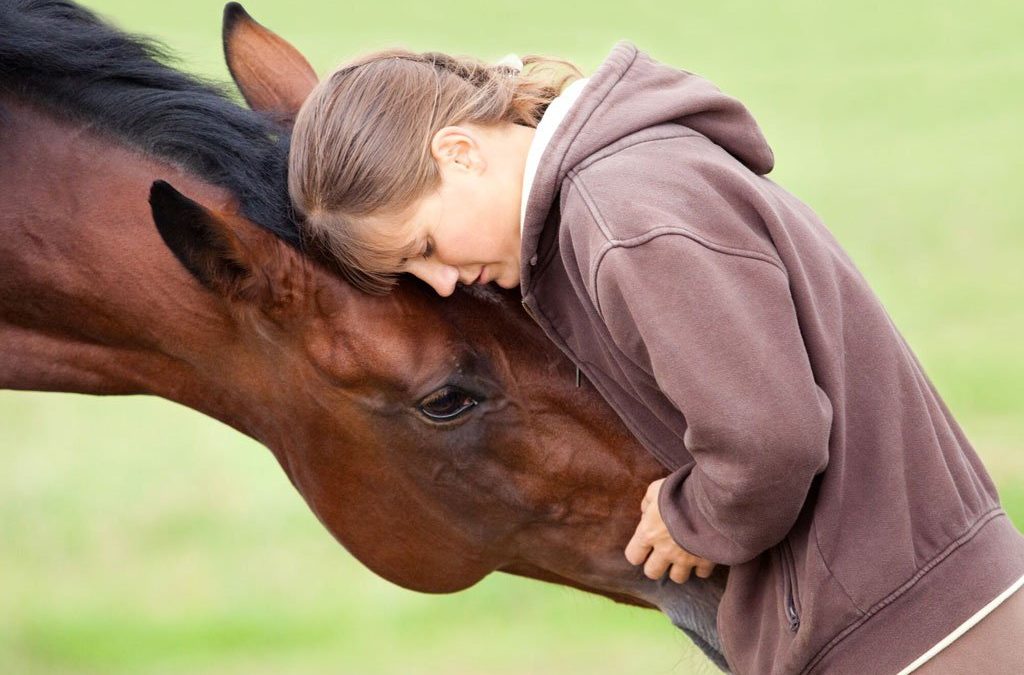Recovering horses require proper nutrition and management to reduce stress
Colic is a nonspecific term that refers to any type of abdominal pain or discomfort. Colic can be acute, chronic, or recurrent and is generally caused by distension or obstruction of the gut with fluid, food being ingested, a foreign object, or gas. Other primary causes of colic include intestinal twisting or torsion or heavy parasite infestation.
Colic involving the gastrointestinal tract can occur in several locations. The four main segments affected are:
- Stomach
- Small intestine
- Large intestine
- Small colon/rectum
In general, colic involving the stomach is most often associated with the presence of gastric ulcers. Obstruction, strangulation, ileus (motionless intestine), motility alterations, and inflammation are leading causes of colic in the small intestine, cecum, and large and small colon.
Obstructions can occur from feed or sand impaction, foreign bodies, enteroliths (mineralized stones), ascarid (roundworm) impaction, stricture, abcesses, and cancer. Additionally, displacement of the colon can be reason for an obstruction to occur. Because the colon folds back on itself several times and has varying diameters in different segments, impactions and other types of colic can result in this area.
Intestinal strangulation may result from twisting of intestine, entrapment of intestines in abdominal structures, diaphramatic hernia, or displacement of intestines into the chest, inguinal hernia where intestine is present in the scrotum of stallions or recently castrated geldings, and umbilical hernias. Older horses also may suffer from colic caused by Lipoma or fatty tumors present in the digestive tract.
Surgical removal of devitalized intestinal tissue may at times be needed to save the life of a horse severely compromised with colic. Colic surgery is categorized as either complicated or uncomplicated based on how much the intestinal tissue is compromised.
Uncomplicated colic generally can be treated systemically using analgesics, fluids, and laxatives and rarely requires surgery. Complicated colic, however, must be dealt with surgically in most cases, as nonviable bowel does not receive the oxygen and nutrients it needs to function properly.
Feeding after surgery
Following surgery to remove part of the small or large intestine, specific dietary alterations must be made to aid in full recovery of the horse. Due to the nature of the digestive tract of the horse and the different sites of digestion and absorption of various nutrients, the feeding regimes for small or large intestine surgeries are very different.
There are no specific dietary changes required for a horse having undergone colic surgery in which no portion of the intestines or the cecum or less than 50% of the jejunum and/or duodenum (first and middle sections of small intestine) were removed.
According to Sarah Ralston, Ph.D, equine nutritionist at Rutgers University, horses recovering from colic surgery should be fed high-quality, highly digestible feeds in small, frequent meals as soon as they are awake from the anesthesia. A good rule is to offer the horse about one-quarter of its normal ration, building up to the normal maintenance ration in a period of several days. Fresh water should be available at all times. Hand walking and grazing on fresh grass for short periods are also desirable
Following surgical removal of a section of the large intestine, horses are generally fasted for 12 to 24 hours. This is done to rest and prevent any distention of the bowel and will aid in the healing of the reconnected bowel. However, after the initial recovery period, it is important to quickly reintroduce solid feed to prevent atrophy of the remaining intestinal tissue. Prolonged fasting for more than 72 hours also can result in compromised healing of the wound and increased susceptibility to infection and diarrhea.
For 30 days after surgery, horses are capable of eating small amounts of high-quality feeds, and the recovering horse will need extra protein (12% or greater) and phosphorus (0.4% minimum) with low amounts of structural fiber (less than 28%) in the daily ration, said Ralston. These dietary alterations are necessary due to the gut’s decreased ability to digest and absorb these nutrients for several weeks after surgery.
Water must be available in ample amounts at all times as horses with large intestine resection have a higher requirement for water as a result of reduced surface area for water absorption. Horses requiring higher caloric density in the ration can be fed alfalfa hay or an alfalfa/grass mix, with small grain meals, if needed.
Horses that have had fairly large sections of both the left and right colon removed may need to remain on this dietary regime for the remainder of their lives. However, those that have had only portions of the left colon and/or cecum removed generally regain the ability to absorb nutrients and may gradually be returned to a normal maintenance ration.
Withhold grain
Horses that have undergone small intestinal surgery require a completely different feeding protocol.
Grain should be withheld completely and only high-quality legume hay should be fed. If additional supplementation is needed to meet nutritional requirements or promote weight gain, feeds containing soluble fibers such as beet pulp, soybean hulls, and rice bran may be added to the diet. Complete feeds, which contain high levels of fiber and can be fed as the sole ration, work well in this scenario.
The small intestine is a primary site for digestion of starch, protein, vitamins, and most minerals except phosphorus, which is absorbed in the large intestine. Horses that have lost part of the ileum are less efficient at absorbing fat and will need to have supplemental fat-soluble vitamins added to their diet.
The large intestine is capable of compensating to some extent for the lack of absorption of protein, carbohydrates, and B vitamins, which are produced by microbes. Calcium absorption also may be compromised in the horse that has undergone small intestine resection since calcium is absorbed primarily here. If bleeding occurs after surgery, Ralston suggested adding vitamin K to the diet, as this vitamin plays a role in promoting blood clotting. Nutrena manufactures a product called Life Design Senior that contains 14% protein and 16% alfalfa-based fiber and is fully fortified with a high level of calcium, phosphorus, and other required vitamins and minerals. It consists of pelleted and extruded nuggets, making it highly digestible and easy for the convalescing horse to eat.
Some horses may need to eat feed that has been soaked in warm water or made into a gruel to allow the feed to move easily through the digestive tract. Concentrated liquid diets can also be used to feed the recovering horse. Ensure, a product designed for human nutritional support, works well in this situation. For an adult horse, 16 liters of Ensure would be required to meet the nutrient requirements of a 1,000-pound horse, an amount large enough to be daunting to administer to a horse even via stomach tube.
Extremely debilitated individuals may need to be fed intravenously until they have recovered sufficiently to eat on their own. Ralston suggested using solutions containing intravenous amino acid and lipid solution as opposed to the traditional 5% dextrose solutions.
Horses that have undergone surgical resection of the bowel require intensive rehabilitative care, and particular attention must be made to reduce stress in their environment and provide proper nutrition. Prognosis for the long-term health and usefulness of the horse is excellent provided extreme caution and attention to detail are executed following surgery.
Procedures at one clinic after colic surgery
Mathea Kelley, a graduate student at the University of Kentucky and a veterinary technician in equine medicine at Hagyard-Davidson-McGee in Lexington, provided the following information regarding post-operative care of colic surgeries.
Horses are generally muzzled for eight hours after surgery and monitored closely for post-surgical complications. Abdominal ultrasounds are per formed to determine if there is movement through the tract, and horses are monitored for the passing of feces. Once this period has passed and the horse has recovered sufficiently, the horse receives small amounts of high-quality feed at frequent intervals.
Each case is evaluated individually but, in general, horses that have undergone small intestinal resection receive only Purina Equine Senior, a complete feed that is offered as a mash. Horses also receive small amounts of high-quality legume hay. If they have any reflux in the stomach after surgery, feed is withheld until the reflux has ceased. Horses that have had large intestine resections are offered only high-quality hay to begin with and little to no grain for several days.
All horses having undergone surgery are fed at least three times daily, if not more frequently. Individuals that do not respond well to solid feeds are given total parenteral nutrition via nasogastic tube.
Additionally, horses are kept on an intravenous fluid drip for a couple of days after surgery. Temperature, pulse, and respiration are taken several times per day. Blood is monitored for volume and dehydration. Horses receive antibiotics, usually K-Pen or Gentocin, for seven to ten days following surgery.
The horse is slowly introduced to hand walking when he appears capable and continues for several weeks until he can tolerate being turned out in a small paddock. Light exercise can be resumed approximately six weeks after surgery if no complications have arisen.
Management techniques to reduce incidence of colic
- Provide excellent dental care to ensure proper grinding of feed
- Supply fresh water and white salt at all times to ensure proper hydration
- Feed a variety of good-quality forages and allow as much access to fresh pasture grass/grazing as possible. For stabled horses, strive to allow 30 minutes of grazing twice a day
- Use high-fat soluble fiber concentrates to minimize digestive upset that can be caused by high-starch diets. Limit grain feeding to no more than 0.4% of body-weight per feeding (four pounds per feeding for a 1,000 pound horse)
- Weigh concentrates instead of using volume measurements such as coffee cans, scoops, or quarts for accuracy
- Feed each horse as an individual based on level of exercise, age, reproductive status, breed, and current body condition
- When changing hay or feed sources, make changes gradually over a ten-day period, slowly introducing new feeds to allow bacterial populations in the gut to adapt
- Deworm horses as needed, using fecal examinations to determine if deworming is necessary, or on a regular basis for stabled horses or those in pastures with high populations of horses
- Use only prescribed amount of anti-inflammatory drugs to control pain and swelling
By Dr. Amy Gill, originally published in the Thoroughbred Times


